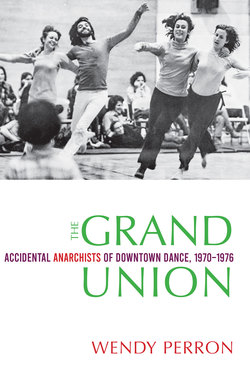Читать книгу The Grand Union - Wendy Perron - Страница 16
На сайте Литреса книга снята с продажи.
ОглавлениеCHAPTER 6
DOUGLAS DUNN
There is nothing easy or breezy about Douglas Dunn’s dancing. He’s pulled up and rigorous, not at all willowy or bendy in the upper body. His limbs extend boldly into space more than those of the others of Grand Union, who tend to have the released flow of the downtown aesthetic. Still connected to the stretched, etched lines of the Cunningham vocabulary, he challenges himself with technically difficult movement. He provides a certain muscularity and determination, never staying within his comfort zone. The motivating force seems to be curiosity. On his face you can read intense concentration as though he’s steadily plowing through some issues while dancing. And yet he can also take on a silly or bawdy character that temporarily blots out his usual introspective quality.
Douglas Dunn (born 1942) came to CP-AD as a young, inexperienced dancer. He wasn’t fighting the artistic powers that be—Graham, Humphrey, Horst—simply because he didn’t know about them. At twenty-six, he found an affinity with Rainer’s work because of his athletic background. “I walked right in the middle of it. I was dancing in Grand Union with no background, no axes to grind.”1
Growing up in the hills outside of Palo Alto, California, he knew how to keep himself occupied. “I invented games for myself because I had no playmates. So I was improvising already. The idea of improvising was sort of simple to me: you go and you do what you want.”2 That faith in translating desire into action, coupled with his ability to explore on his own, went a long way in Grand Union. Whenever he was stranded in a situation, he always found something to arouse his interest. He was present at all moments, not just when he thought he was part of something significant. While others waited for an action to coalesce, he always kept his dancing going. Dancing wasn’t just a holding pattern, a way station on the path to the next big moment. It wasn’t nothing waiting to become something. It was a constant exploration.
Dunn’s inner resource of finding focus on his own was an anchor for Grand Union. One time in the 1975 Walker lobby performance, when isolated solos and duets were scattered around the space, he started extending his leg along the floor and edging his toes under a carpet—a small movement that evolved into a full-blown dance sequence.
In the early seventies, Dunn was at a point in his life where he was happy to find a more physical, less verbal field of activity. He had majored in art history at Princeton and spent three years teaching Spanish at a high school. “[M]y life had been much too thought-oriented up to that time, and I was expanding into this intuitive world of dance. It was so satisfying. I didn’t want to talk.”3 One can see evidence of this aversion in his nearly monosyllabic answers to Banes’s questions about the Grand Union experience at the end of Terpsichore in Sneakers. As he later wrote, “[O]ne of the beauties of dancing is silence.”4 It took awhile before he could utilize his remarkable verbal acuity in Grand Union performances.
Dunn could “play” himself, but he could just as easily play a character. I remember when he dressed as a man of the cloth at NYU, and I’ve read about when he dressed as a Tin Woodsman at UCLA.5 One time at LoGiudice, he wore a bonnet that gave him a kooky look, like a homeless man who had donned the only head covering he could find. Or maybe he was the “nervous clown,” an epithet he used to describe a character he sometimes fell into (and that character became more prevalent in the older Douglas Dunn of recent years).6 As a dancer/researcher, he was always implicitly asking: Who am I in this environment?
Having spent a lot of time outdoors as a kid, Dunn could envision bringing nature into the theater. In 1975 he collected bags of leaves from their host’s backyard in Minneapolis and spread them around the Walker Art Center lobby.
He was open to the space and the people around him. From his time in GU, he developed a taste for the absurd. He describes a performance in Rome’s 1974 Contemporanea Festival in a parking lot, where he found a ball the size of a tennis ball. “I put it in my mouth and did a monologue,” he said, demonstrating how muffled and obstructed a foreign language might sound. “I never would have thought of doing that without the context of all these people doing very strange things all the time. So it did stimulate characters in me that I didn’t know I had available.”7
In the realm of character, he could be quite loud, boisterous, and even crude. During the 1975 Guthrie performance Gordon cast him as a contestant in a TV show. As a kind of sophomoric frat guy named “Marvin,” he became pushy (“Let’s get on with this show”) and yelled to Dilley to pump the crowd. In the same performance, he colluded with Gordon in talking about how to pick up women. They did it in a funny, absurdist way, but in that particular scene, he was not the thoughtful Douglas Dunn that most of us know.
Douglas rose to the greatest challenge of Grand Union: to make something out of nothing. “The fun for me was to walk in just blank, just completely blank, and to make oneself available to different degrees with other people about what would happen.”8
